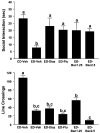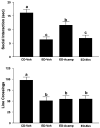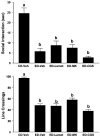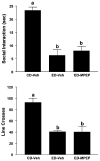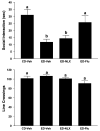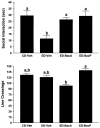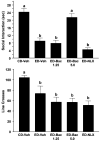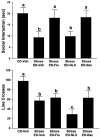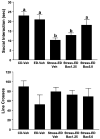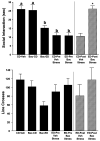Baclofen blocks expression and sensitization of anxiety-like behavior in an animal model of repeated stress and ethanol withdrawal - PubMed (original) (raw)
Baclofen blocks expression and sensitization of anxiety-like behavior in an animal model of repeated stress and ethanol withdrawal
Darin J Knapp et al. Alcohol Clin Exp Res. 2007 Apr.
Abstract
Background: Repeated exposures to forced ethanol diets (EDs) or restraint stress sensitize anxiety-like behavior during a future ethanol withdrawal. The present investigation assessed whether pretreatment of rats with agents targeting receptor systems thought to be important in treating relapse in alcoholic patients would prevent sensitization of anxiety-like behavior.
Methods: Groups of rats were exposed to either (1) three 5-day cycles of ED with 2 days of withdrawal between cycles, (2) continuous ED, or (3) 5 days of ED in a single cycle preceded by 2 episodes of restraint stress 6 days apart. Drugs [baclofen, acamprosate, naloxone, lamotrigine, ifenprodil, dizocilpine (MK-801), CGS19755, diazepam, flumazenil, or 6-methyl-2-(phenylethynyl)pyridine] were given prophylactically during the first and second withdrawal periods only or, in separate baclofen experiments, acutely during the third withdrawal or during withdrawal from continuous ED. Baclofen administration preceded each stress session in the stress-withdrawal protocols. Anxiety-like behavior was assessed in the social interaction (SI) test 5 hours after the ethanol was removed or after 3 days of abstinence.
Results: Baclofen (1.25, 2.5, and 5 mg/kg), flumazenil (5 mg/kg), and diazepam (1 mg/kg) blocked the reduction in SI induced by ethanol withdrawal. Among the drugs that alter glutamate function, only acamprosate (300 mg/kg) was effective. In the stress protocols, baclofen (5 mg/kg) given before each of the 2 restraint stress sessions before ethanol exposure or before stress during abstinence also attenuated SI deficits.
Conclusions: These findings suggest that GABAB and GABAA, but not glutamate or opioid mechanisms, are involved in adaptive changes associated with anxiety-like behavior induced by these repeated ethanol-withdrawal and stress-withdrawal paradigms. The lack of action of agents attenuating different aspects of glutamate function suggests that acamprosate's action is related to some other, as yet undetermined, mechanism.
Figures
Fig. 1
Acute actions of baclofen, flumazenil, and diazepam on social interaction (SI) during withdrawal from prolonged 7% ethanol diet (ED). Rats were exposed to control diet (CD) throughout or 23 days of 7% ED before withdrawal. Rats exposed to ED were injected with 1 mg/kg diazepam (ED-Diaz), 5 mg/kg flumazenil (ED-Flu), or 1.25 or 2.5 mg/kg baclofen (ED-Bac1.25 or ED-Bac5.0) 30 min (10 for Flu) before the SI test. SI behavior and line crossings were recorded 5 h after withdrawal. Bars represent the means ± SEM. Groups with different letters are significantly different from each other (Tukey’s protected _t_-tests).
Fig. 2
Prophylactic actions of acamprosate but not ifenprodil on the reduced social interaction (SI) time induced by repeated chronic exposures to 7% ethanol diet (ED). Rats were exposed to control diet (CD) throughout or 3 cycles of 5 days’ exposure to 7% ED. Rats exposed to ED were treated with vehicle (ED-Veh), 300 mg/kg acamprosate (ED-Acamp), or 10 mg/kg ifenprodil (ED-Ifen) 4 h into the first and second withdrawals. Social interaction behavior and line crossings were recorded 5 h after the last withdrawal. Data represent the means ± SEM. Groups with different letters are significantly different from each other (Tukey’s protected _t_-tests).
Fig. 3
Failure of lamotrigine, dizocilpine (MK-801), or CGS19755 to prevent reduced social interaction (SI) time induced by repeated chronic exposures to 7% ethanol diet (ED). Rats were exposed to control diet (CD) throughout or 3 cycles of 5 days’ exposure to 7% ED. Rats exposed to ED were injected with vehicle (ED-V), 30 mg/kg lamotrigine (ED-Lamot), 0.3 mg/kg dizocilpine (ED-MK), or 10 mg/kg CGS19755 (ED-CGS) at 4 h into the first and second withdrawals. Social interaction behavior and line crossings were recorded 5 h into withdrawal after the third ethanol exposure was stopped. Bars represent the means ± SEM. Groups with different letters are significantly different from each other (Tukey’s protected _t_-tests).
Fig. 4
Inactivity of 6-methyl-2-(phenylethynyl)pyridine (MPEP) against reduced social interaction (SI) time in rats repeatedly withdrawn from chronic 4.5% ethanol diet (ED). Rats were exposed to control diet (CD) throughout or 3 cycles of 5 days’ exposure to 4.5% ED. The rats exposed to ED were injected with vehicle (ED-Veh) or 10 mg/kg MPEP 4 h into the first and second withdrawal. Social interaction behavior and line crossings were recorded 5 h after the last ethanol exposure was stopped. Bars represent the means ± SEM. Groups with different letters are significantly different from each other (Tukey’s protected _t_-tests).
Fig. 5
Prophylactic effects of flumazenil but not naloxone on reduced social interaction (SI) behavior in rats repeatedly withdrawn from 4.5% ethanol diet (ED). Rats were exposed to control diet (CD) throughout or 3 cycles of 5 days’ exposure to 4.5% ED. Rats exposed to ED were injected with vehicle (ED-Veh), 20 mg/kg naloxone (ED-NLX), or 5 mg/kg flumazenil (ED-Flu) 4 h into the first and second withdrawals. Social interaction behavior and line crossings were recorded 5 h after the third ethanol exposure was stopped. Bars represent the means ± SEM. Groups with different letters are significantly different from each other (Tukey’s protected _t_-tests).
Fig. 6
Acute and prophylactic effects of baclofen on reduced social interaction (SI) in rats repeatedly withdrawn from chronic 4.5% ethanol diet (ED). Rats were exposed to control diet (CD) throughout or 3 cycles of 5 days’ exposure to 4.5% ED. The rats exposed to ED were injected with vehicle (ED-Veh) or 2.5 mg/kg baclofen (ED-Bac2.5) 4 h into the first and second withdrawal or with 1.25 mg/kg baclofen (ED-Bac1.25) 4.5 h into the third withdrawal. Social interaction behavior and line crossings were recorded 5 h into withdrawal after the third ethanol exposure was stopped. Bars represent the means ± SEM. Groups with different letters are significantly different from each other (Tukey’s protected _t_-tests).
Fig. 7
Prophylactic effects of baclofen against reduced social interaction (SI) in rats repeatedly withdrawn from 4.5% ethanol diet (ED). Rats were exposed to control diet (CD) throughout or 3 cycles of 5 days’ exposure to 4.5% ED. The rats exposed to ED were injected with vehicle (ED-Veh) or 1.25 or 5 mg/kg baclofen, or 5 mg/kg naloxone 4 h into the first and second withdrawal periods. Social interaction behavior and line crossings were recorded 5 h after the last ethanol exposure was stopped. Bars represent the means ± SEM. Groups with different letters are significantly different from each other (Tukey’s protected _t_-tests).
Fig. 8
Actions of flumazenil and baclofen, but not naloxone, against stress-enhanced ethanol withdrawal anxiety. Rats were exposed to control diet (CD), restraint stressed twice (6 days apart; 45 min each session), and then given 4.5% ED for 5 days before social interaction (SI) testing. Thirty minutes before each stress (10 min for flumazenil), rats were treated with either vehicle, flumazenil (5 mg/kg), naloxone (20 mg/kg), or baclofen (2.5 mg/kg), respectively. Social interaction testing was carried out 5 h after ethanol exposure was stopped. Bars represent the means ± SEM. Groups with different letters are significantly different from each other (Tukey’s protected _t_-tests).
Fig. 9
Baclofen (1.25 and 5 mg/kg) actions against stress-enhanced ethanol withdrawal anxiety: additional doses. Rats were treated as in Fig. 8, except that subgroups received either 1.25 or 5.0 mg/kg baclofen 30 min before the stress sessions. An additional group was not subjected to stress. Bars represent the means ± SEM. Groups with different letters are significantly different from each other (Tukey’s protected _t_-tests). CD, control diet.
Fig. 10
Acute actions of baclofen against stress-elicited social interaction (SI) deficits during abstinence from ethanol diet (ED) but no effects of prophylactic baclofen in animals not exposed to ED. Groups of rats were exposed to control diet (CD) and given either vehicle (CD-Veh) or baclofen (Bac-CD) twice or were similarly exposed to CD and baclofen, followed by one 5-day cycle of 4.5% ED (Bac-ED). Two additional groups were exposed to ED for 3 cycles, behaviorally tested to confirm the sensitization of anxiety (ED-Pre Veh stress and ED-Pre Bac stress) during withdrawal, and then retested immediately after administration of a single restraint stress (45 min) 3 days into abstinence. Baclofen had no effect on rats given only CD, tended to increase anxiety in animals subsequently exposed to 1 ED cycle (Bac-ED), and completely reversed stress-elicited anxiety in the multiply withdrawn abstinent rats (ED-Post Bac stress). Bars represent the means ± SEM. Groups with different letters are significantly different from each other (Tukey’s protected _t_-tests). *Significantly different from the stressed Veh-treated group (ED-Post Veh stress).
Similar articles
- Modulation of ethanol withdrawal-induced anxiety-like behavior during later withdrawals by treatment of early withdrawals with benzodiazepine/gamma-aminobutyric acid ligands.
Knapp DJ, Overstreet DH, Breese GR. Knapp DJ, et al. Alcohol Clin Exp Res. 2005 Apr;29(4):553-63. doi: 10.1097/01.alc.0000158840.07475.97. Alcohol Clin Exp Res. 2005. PMID: 15834220 Free PMC article. - Sensitization, duration, and pharmacological blockade of anxiety-like behavior following repeated ethanol withdrawal in adolescent and adult rats.
Wills TA, Knapp DJ, Overstreet DH, Breese GR. Wills TA, et al. Alcohol Clin Exp Res. 2009 Mar;33(3):455-63. doi: 10.1111/j.1530-0277.2008.00856.x. Epub 2008 Dec 13. Alcohol Clin Exp Res. 2009. PMID: 19120055 Free PMC article. - Prior multiple ethanol withdrawals enhance stress-induced anxiety-like behavior: inhibition by CRF1- and benzodiazepine-receptor antagonists and a 5-HT1a-receptor agonist.
Breese GR, Overstreet DH, Knapp DJ, Navarro M. Breese GR, et al. Neuropsychopharmacology. 2005 Sep;30(9):1662-9. doi: 10.1038/sj.npp.1300706. Neuropsychopharmacology. 2005. PMID: 15726114 Free PMC article. - Alcohol withdrawal and conditioning.
Little HJ, Stephens DN, Ripley TL, Borlikova G, Duka T, Schubert M, Albrecht D, Becker HC, Lopez MF, Weiss F, Drummond C, Peoples M, Cunningham C. Little HJ, et al. Alcohol Clin Exp Res. 2005 Mar;29(3):453-64. doi: 10.1097/01.alc.0000156737.56425.e3. Alcohol Clin Exp Res. 2005. PMID: 15770122 Review.
Cited by
- Persistent adaptation by chronic alcohol is facilitated by neuroimmune activation linked to stress and CRF.
Breese GR, Knapp DJ. Breese GR, et al. Alcohol. 2016 May;52:9-23. doi: 10.1016/j.alcohol.2016.01.005. Epub 2016 Feb 24. Alcohol. 2016. PMID: 27139233 Free PMC article. Review. - GABAB Receptors and Alcohol Use Disorders: Preclinical Studies.
Holtyn AF, Weerts EM. Holtyn AF, et al. Curr Top Behav Neurosci. 2022;52:157-194. doi: 10.1007/7854_2020_178. Curr Top Behav Neurosci. 2022. PMID: 32808090 - Theoretical frameworks and mechanistic aspects of alcohol addiction: alcohol addiction as a reward deficit disorder.
Koob GF. Koob GF. Curr Top Behav Neurosci. 2013;13:3-30. doi: 10.1007/7854_2011_129. Curr Top Behav Neurosci. 2013. PMID: 21744309 Free PMC article. Review. - A preliminary double-blind, placebo-controlled randomized study of baclofen effects in alcoholic smokers.
Leggio L, Zywiak WH, Edwards SM, Tidey JW, Swift RM, Kenna GA. Leggio L, et al. Psychopharmacology (Berl). 2015 Jan;232(1):233-43. doi: 10.1007/s00213-014-3652-9. Epub 2014 Jun 29. Psychopharmacology (Berl). 2015. PMID: 24973894 Free PMC article. Clinical Trial. - The GABAB receptor positive allosteric modulator ASP8062 reduces operant alcohol self-administration in male and female Sprague Dawley rats.
Haile CN, Carper BA, Nolen TL, Kosten TA. Haile CN, et al. Psychopharmacology (Berl). 2021 Sep;238(9):2587-2600. doi: 10.1007/s00213-021-05881-0. Epub 2021 Jul 6. Psychopharmacology (Berl). 2021. PMID: 34228136
References
- Addolorato G, Caputo F, Capristo E, Colombo G, Gessa GL, Gasbarrini G. Ability of baclofen in reducing alcohol craving and intake: II—Preliminary clinical evidence. Alcohol Clin Exp Res. 2000;24:67–71. - PubMed
- Addolorato G, Caputo E, Capristo E, Domenicali M, Bernardi M, Janin L, Agabio A, Colombo G, Gessa GL, Gasbarrini G. Baclofen efficacy in reducing alcohol craving and intake: a preliminary double-blind, randomized controlled study. Alcohol Alcohol. 2002;37:504–508. - PubMed
- Addolorato G, Leggio L, Abenavoli L, Agabio R, Caputo F, Capristo E, Colombo G, Gessa GL, Gasbarrini G. Baclofen in the treatment of alcohol withdrawal syndrome: a comparative study vs diazepam. Am J Med. 2006;119:276.e13–18. - PubMed
- Akhondzadeh S, Ahmadi-Abhari SA, Assadi SM, Shabestari OL, Kashani AR, Farzanehgan ZM. Double-blind randomized controlled trial of baclofen vs. clonidine in the treatment of opiate withdrawal. J Clin Pharm Ther. 2000;25:347–353. - PubMed
- Alvarez C, Prunell M, Boada J. Effect of naloxone on behavioral changes induced by subchronic administration of ethanol in rats. Pharmacol Biochem Behav. 1998;59:961–965. - PubMed
Publication types
MeSH terms
Substances
Grants and funding
- AA-11605/AA/NIAAA NIH HHS/United States
- R01 AA014949-05/AA/NIAAA NIH HHS/United States
- P60 AA011605/AA/NIAAA NIH HHS/United States
- P50 AA011605-050005/AA/NIAAA NIH HHS/United States
- R01 AA014284/AA/NIAAA NIH HHS/United States
- AA-14284/AA/NIAAA NIH HHS/United States
- AA-14949/AA/NIAAA NIH HHS/United States
- R01 AA014284-05/AA/NIAAA NIH HHS/United States
- P50 AA011605/AA/NIAAA NIH HHS/United States
- R01 AA014949/AA/NIAAA NIH HHS/United States
- Z01 AA000214/ImNIH/Intramural NIH HHS/United States
